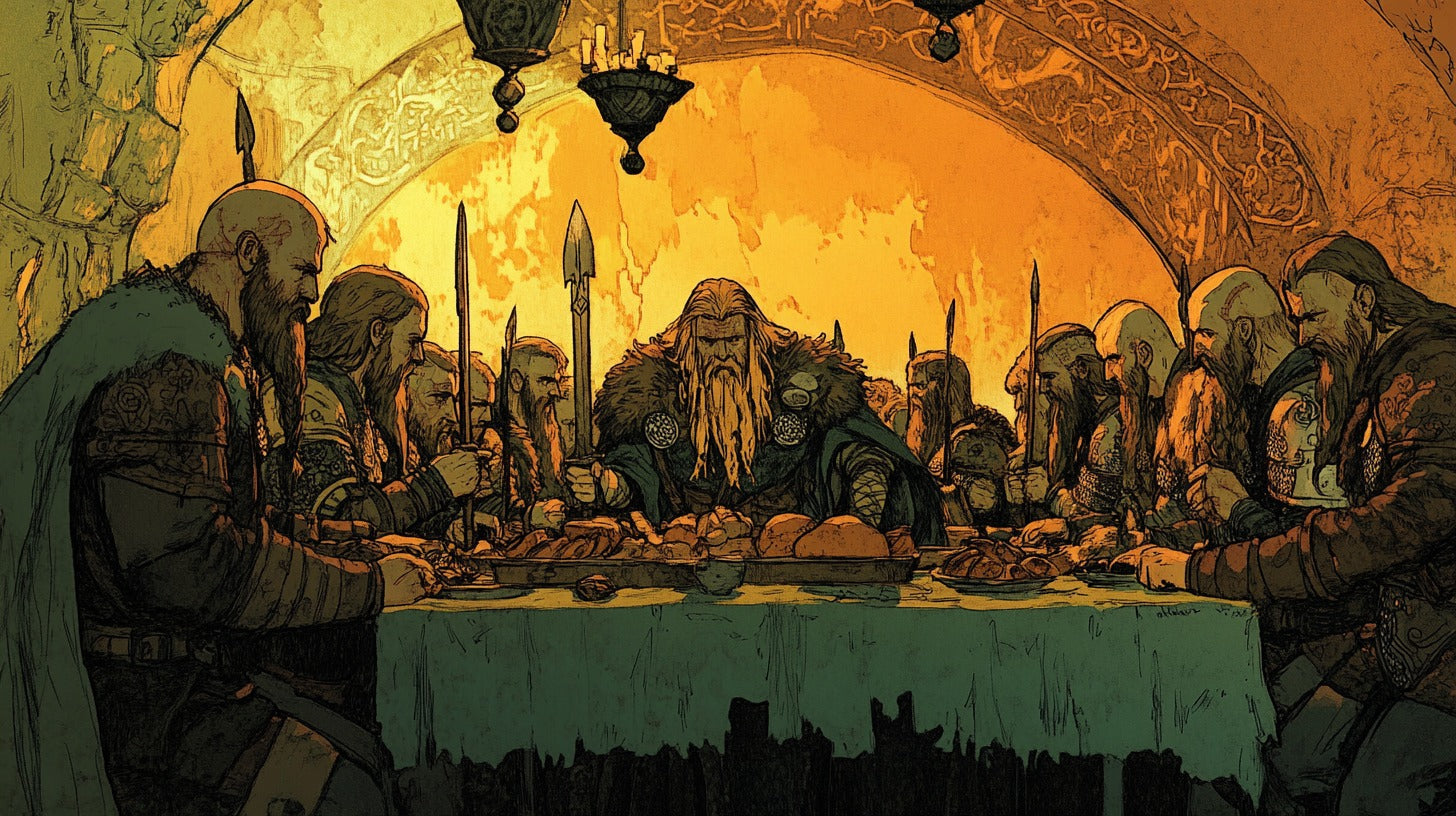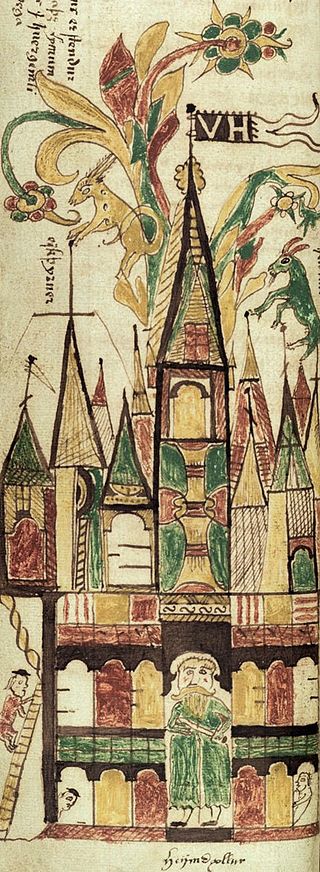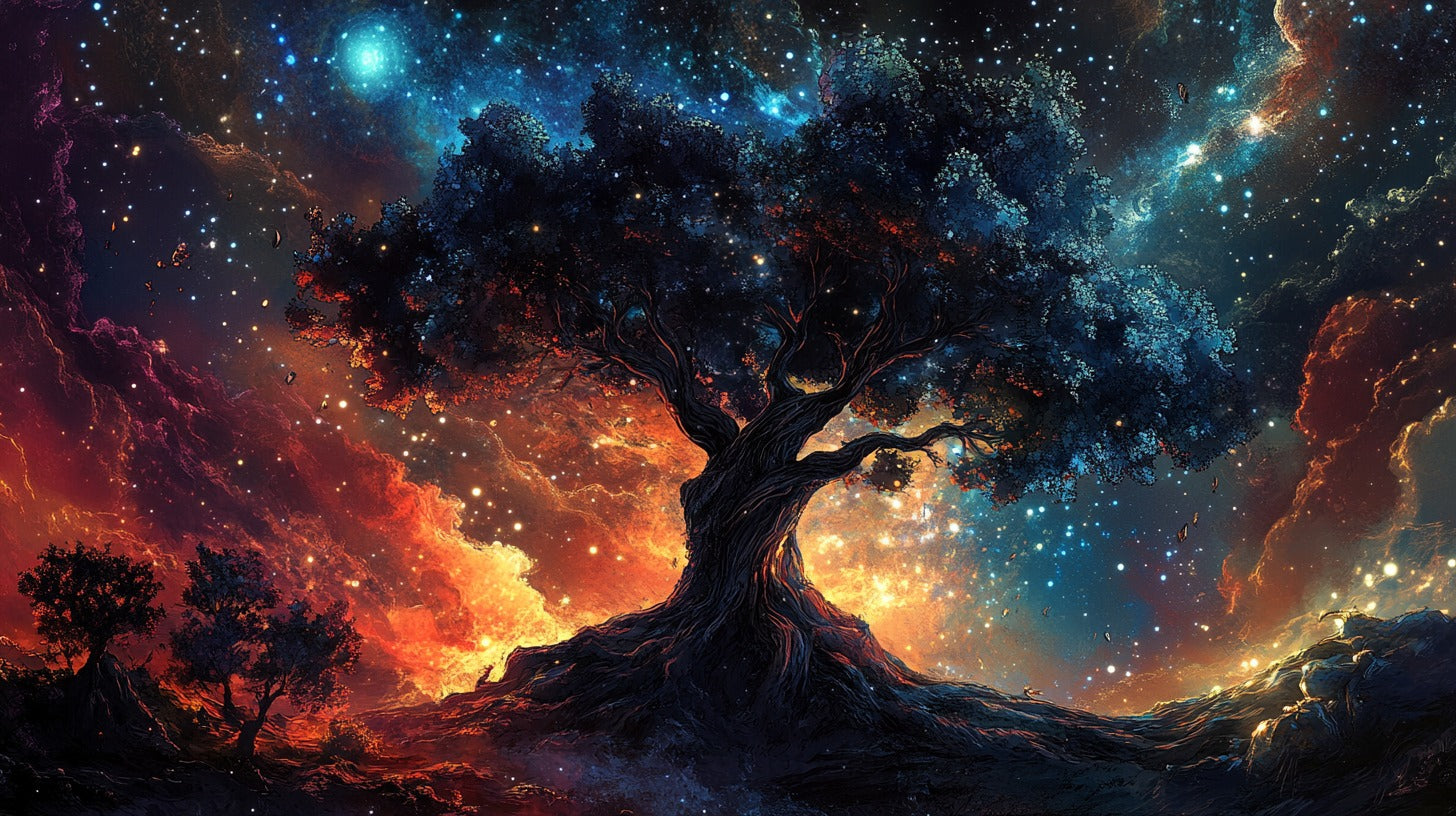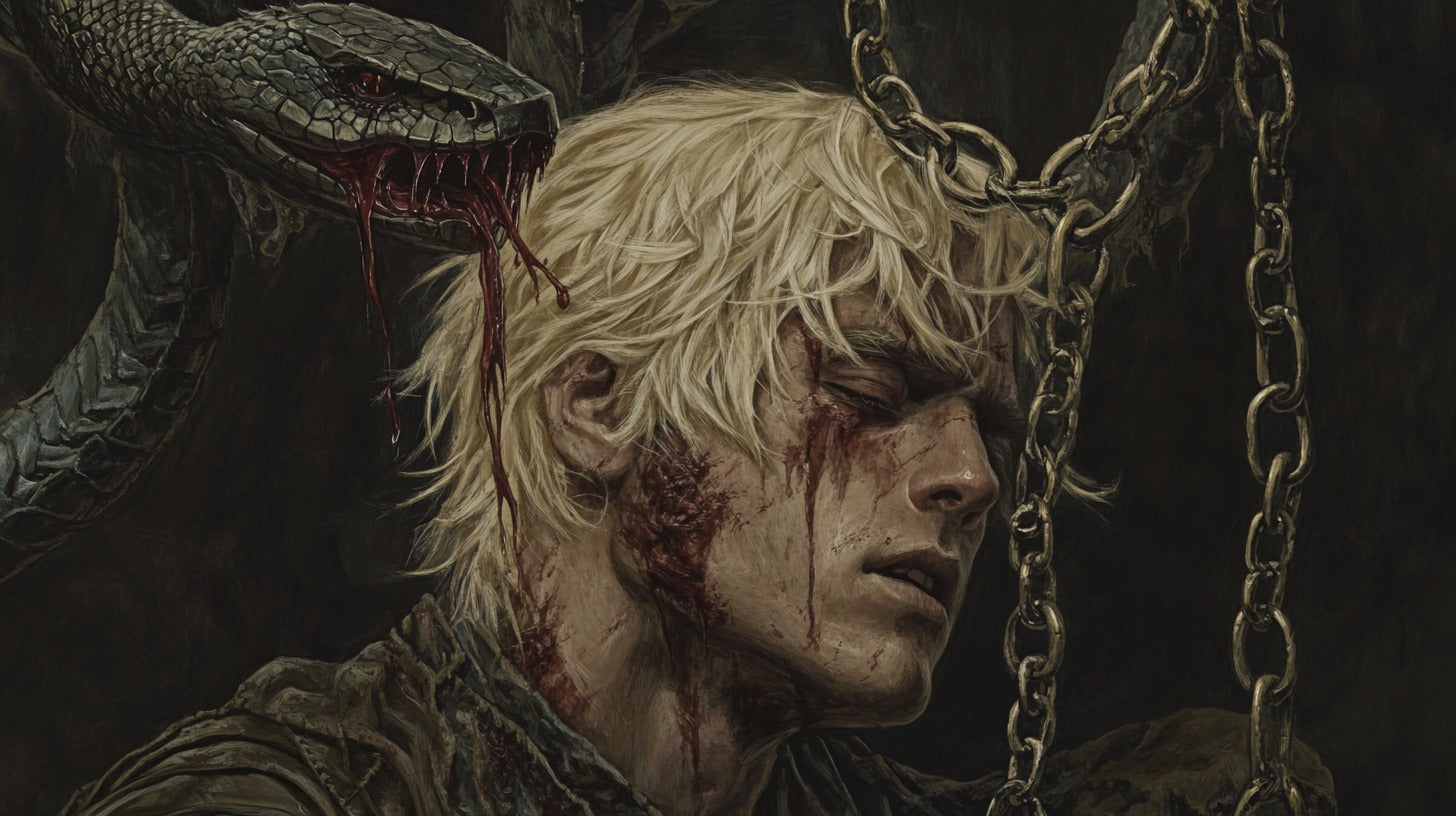
Eternal Glory: The Myth and Meaning of Valhalla
In the mist-shrouded realms of Norse mythology, where gods and giants clash and the fate of the cosmos hangs in delicate balance, there stands a hall of unparalleled grandeur. Its rafters echo with the clash of steel and the boisterous laughter of fallen warriors. This, dear reader, is Valhalla - the ultimate reward for those who have proven their mettle in the crucible of battle.
Origins and Mythology

Etymology of Valhalla
The very name "Valhalla" conjures images of glory and eternal celebration. But what does it truly mean? In the ancient Norse tongue, "Valhöll" - as it was originally known - translates to "hall of the slain." It's a fitting moniker for a place where the bravest of the brave find their final rest, or perhaps more accurately, their eternal beginning.
Odin's Role in Valhalla
At the heart of Valhalla's myth stands the enigmatic figure of Odin, the Allfather of Norse gods. One-eyed and all-seeing, Odin presides over this hallowed hall like a general over his most elite troops. But why, you might ask, does a god need an army of the dead? The answer lies in the looming shadow of Ragnarök, the twilight of the gods, where every warrior will be needed in the final battle.
The Structure and Appearance of Valhalla

An illustration from a 17th century Icelandic manuscript showing Heimdall guarding the gate of Valhalla
The Golden Hall
Imagine a hall so vast that it disappears into the horizon, its golden roof gleaming like a second sun in the ethereal light of Asgard. This is Valhalla, a structure of such impossible grandeur that it defies mortal comprehension. Its walls are said to be fashioned from the spears of fallen warriors, while shields form its lustrous roof.
The 540 Doors
Five hundred and forty doors pierce the walls of Valhalla, each wide enough for eight hundred warriors to march through abreast. Why such specific numbers, you ask? In Norse mythology, numbers often carry deep symbolic meaning. The sheer scale of these entrances speaks to the multitudes of brave souls Valhalla is prepared to welcome, while also hinting at the massive exodus that will occur when Ragnarök finally dawns.
Life in Valhalla

Valhalla (1905) by Emil Doepler
The Einherjar: Chosen Warriors
Those who dwell within Valhalla's hallowed halls are known as the Einherjar - the "lone fighters" or "once warriors." These are not just any fallen soldiers, mind you. The Einherjar represent the crème de la crème of mortal combatants, hand-picked by Odin himself (with a little help from his Valkyries, but we'll get to them later).
Daily Activities and Feasts
The Eternal Battle
You might think that the afterlife would be a time for rest and reflection. Not so in Valhalla. Each day, the Einherjar arm themselves and march out onto the field of Idavoll, where they engage in glorious combat. Limbs are hewn, blood is spilled, and warriors fall - only to rise again, wounds healed, ready to fight and fall once more. It's a never-ending cycle of battle, a constant honing of skills in preparation for the final conflict.
The Nightly Feast
As the sun sets on Asgard, the Einherjar set aside their weapons and return to Valhalla's vast feast hall. Here, they dine on the flesh of Sæhrímnir, a magical boar that restores itself each day, and drink rivers of mead that flow from the udders of the goat Heiðrún. It's a raucous affair, with tales of battle echoing off the golden walls and the mead flowing as freely as the blood did earlier in the day.
Valkyries: The Choosers of the Slain

The Valkyries Hildr, Þrúðr and Hlökk bearing ale in Valhalla (1895) by Lorenz Frølich
Role and Responsibilities
No discussion of Valhalla would be complete without mentioning the Valkyries. These fierce warrior maidens, whose name means "choosers of the slain," are Odin's handmaidens and scouts. They soar over battlefields astride flying horses, their armor gleaming, deciding who among the fallen is worthy of a place in Valhalla.
Famous Valkyries in Norse Mythology
Among the ranks of the Valkyries, certain names stand out. Brynhildr, whose tragic tale of love and betrayal formed the basis for Wagner's epic opera. Sigrún, who defied her father's wishes to be with her lover. These are not mere ferrymen for the dead, but complex characters with their own stories, desires, and fates intertwined with those of gods and mortals alike.
Valhalla in Norse Literature
Poetic Edda
The Poetic Edda, that treasure trove of Norse mythological verses, paints vivid pictures of Valhalla. In the poem "Grímnismál," Odin himself describes the hall:
"Five hundred doors
and forty there are,
I believe, in Valhalla;
Eight hundred Einherjar
will go out of each door
when they go to fight the wolf."
These words give us a sense of the sheer scale of Valhalla and the army it houses.
Prose Edda
Snorri Sturluson's Prose Edda provides us with a more structured account of Valhalla, describing its appearance and the daily lives of its inhabitants. It's from Snorri that we get many of the details about the feasts, the battles, and the role of the Valkyries.
The Significance of Valhalla in Norse Culture

Warrior Ethos and Afterlife Beliefs
The concept of Valhalla tells us much about the values of the Norse people. Here was a culture that prized bravery and martial prowess above all else, where the greatest reward in the afterlife was not eternal peace, but eternal battle. It speaks to a worldview where conflict was not something to be avoided, but embraced as a path to glory.
Influence on Viking Society
The promise of Valhalla likely served as a powerful motivator for Viking warriors. Imagine facing your enemies, knowing that death in battle wasn't an end, but a beginning - a ticket to an eternity of feasting and fighting alongside the gods. It's a belief system perfectly suited to a society of raiders and explorers, where bravery in the face of death was a necessity.
Valhalla and Ragnarök

The Einherjar, Odin's own personal army doomed to fall during Ragnarök / Illustration: Paganheim
The Final Battle
All of this feasting and fighting serves a greater purpose. Ragnarök, the twilight of the gods, looms on the horizon of Norse mythology. When this final battle comes, the Einherjar will march out of Valhalla's many doors to fight alongside Odin against the forces of chaos and destruction.
Fate of the Einherjar
Ironically, the very event that the Einherjar have been preparing for will also spell their doom. In the cataclysm of Ragnarök, gods and Einherjar alike will fall. It's a bittersweet end - a chance for mortal warriors to prove themselves alongside the gods, but also the twilight of their eternal reward.
Modern Interpretations and Cultural Impact
Valhalla in Literature and Art
The concept of Valhalla has inspired countless works of art and literature. From Wagner's "Der Ring des Nibelungen" to modern fantasy novels, the image of the glorious hall of fallen warriors continues to captivate imaginations.
Valhalla in Popular Culture
In recent years, Valhalla has found new life in video games, movies, and television shows. These modern interpretations often play fast and loose with the original mythology, but they speak to the enduring power of the concept - a warrior's paradise where the brave are rewarded and the battle never ends.
Conclusion
Valhalla stands as a testament to the Norse vision of an ideal afterlife - one of eternal combat, camaraderie, and feasting. It's a reflection of a culture that valued bravery and martial prowess above all else, where even death was seen not as an end, but as a potential path to glory.
As we look back on this ancient concept, we might find it alien or even barbaric. Yet there's something undeniably compelling about the idea of Valhalla. Perhaps it speaks to a part of us that longs for meaning in conflict, that seeks reward for courage, that hopes our struggles in life might lead to something greater.
In the end, Valhalla reminds us that how we envision the afterlife says as much about how we view life itself. For the Norse, life was a battle, and so too was their eternity. What, then, does our modern conception of an ideal afterlife say about us?
FAQs
- Who gets to go to Valhalla?
According to Norse mythology, Valhalla is reserved for warriors who die bravely in battle. Half of those chosen by the Valkyries go to Valhalla, while the other half go to the goddess Freyja's hall, Fólkvangr.
- What happens in Valhalla every day?
The fallen warriors, known as Einherjar, engage in battle during the day, feasting and drinking at night. This cycle prepares them for their role in Ragnarök, the final battle at the end of the world.
- Is Valhalla only for Vikings?
While Valhalla is part of Norse mythology, which was primarily followed by Vikings, the myths don't specify that only Vikings can enter Valhalla. In theory, any warrior who dies bravely in battle could be chosen.
- What's the difference between Valhalla and Heaven?
Unlike the Christian concept of Heaven as a place of eternal peace, Valhalla is characterized by continuous battle and feasting. It's seen more as a warrior's paradise than a peaceful afterlife for all.
- Does everyone in Norse mythology go to Valhalla when they die?
No, Valhalla is just one of several afterlife destinations in Norse mythology. Others include Hel (a general underworld for those who die of old age or disease), Fólkvangr (Freyja's hall for warriors), and Ran's hall beneath the sea for those who drown.
References
Sturluson, S. (13th century). The Prose Edda. Translated by A. Faulkes (1995). Everyman.
Larrington, C. (Trans.). (2014). The Poetic Edda (2nd ed.). Oxford University Press.
Davidson, H. R. E. (1964). Gods and Myths of Northern Europe. Penguin Books.
Lindow, J. (2001). Norse Mythology: A Guide to the Gods, Heroes, Rituals, and Beliefs. Oxford University Press.
Price, N. (2020). Children of Ash and Elm: A History of the Vikings. Basic Books.
"Valhalla Fight Club" by zayzayem is licensed under CC BY-SA 2.0.









